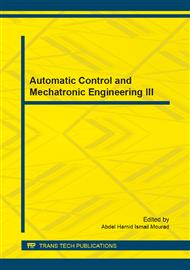[1]
J. Richard, Time-delay systems: an overview of some recent advances and open problems, Automatica, 39 (2003) 1667-1694.
DOI: 10.1016/s0005-1098(03)00167-5
Google Scholar
[2]
E. Moulay, M. Dambrine, N. Yeganefar, et al., Finite time stability and stabilization of time delay systems, Systems and Control Letters, 57 (2008) 561-566.
DOI: 10.1016/j.sysconle.2007.12.002
Google Scholar
[3]
V. Utkin, Sliding modes in control and optimization, Berlin, Springer-Verlag, (1992).
Google Scholar
[4]
Y. Xia, Y. Jia, Robust sliding-mode control for uncertain time-delay systems: an LMI approach, IEEE Transactions on Automatic Control, 48 (2003) 1086-1092.
DOI: 10.1109/tac.2003.812815
Google Scholar
[5]
W. Cao, J. Xu, Nonlinear integral-type sliding surface for both matched and unmatched uncertain systems, IEEE Transactions on Automatic Control, 49 (2004) 1355-1360.
DOI: 10.1109/tac.2004.832658
Google Scholar
[6]
H. Xing, C. Gao, D. Li, Sliding mode variable structure control for parameter uncertain stochastic systems with time-varying delay, Journal of Mathematical Analysis and Applications, 355 (2009) 689-699.
DOI: 10.1016/j.jmaa.2009.02.005
Google Scholar
[7]
S. Ma, E. Boukas, A singular system approach to robust sliding mode control for uncertain Markov jump systems, Automatica, 45 (2009) 2707-2713.
DOI: 10.1016/j.automatica.2009.07.027
Google Scholar
[8]
Levant, Quasi-continuous high-order sliding-mode controllers, IEEE Transactions on Automatic Control, 50 (2005) 1812-1816.
DOI: 10.1109/tac.2005.858646
Google Scholar
[9]
C. Gao, Z. Liu, R. Xu, On exponential stabilization for a class of neutral-type systems with parameter uncertainties: An integral sliding mode approach, Applied Mathematics and Computation, 219 (2013) 11044-11055.
DOI: 10.1016/j.amc.2013.04.038
Google Scholar
[10]
Bandyopadhyay, D. Fulwani, K. Kim, Sliding mode control using novel sliding surface, Berlin, Springer-Verlag, (2009).
Google Scholar
[11]
Bandyopadhyay, D. Fulwani, A robust tracking controller for uncertain MIMO plant using nonlinear sliding surface, Proc. IEEE International Conference on Industrial Technology, Gippsland, Australia, February 2009, 1–6.
DOI: 10.1109/icit.2009.4939667
Google Scholar
[12]
S. Mondal, C. Mahanta, Nonlinear sliding surface based second order sliding mode controller for uncertain linear systems, Commun. Nonlinear Sci. Numer. Simu-lat, 16 (2011) 3760-3769.
DOI: 10.1016/j.cnsns.2010.12.020
Google Scholar
[13]
K. Gu, An integral inequality in the stability problem of time-delay systems, Proc. 39th IEEE conference on decision and control, Sydney, Australia, December 2000, 2805-2810.
DOI: 10.1109/cdc.2000.914233
Google Scholar
[14]
H. Shao, New delay-dependent stability criteria for systems with interval delay, Automatica, 45 (2009) 744-749.
DOI: 10.1016/j.automatica.2008.09.010
Google Scholar
[15]
S. Boyd, L. Ghaoui, E. Feron, et al., Linear matrix inequalities in system and control theory, Society for Industrial and Applied Mathematics, SIAM, (1994).
DOI: 10.1137/1.9781611970777
Google Scholar
[16]
L. Xie, Output feedback H∞ control of systems with parameter uncertainty, International Journal of Control, 63 (1996) 741-750.
DOI: 10.1080/00207179608921866
Google Scholar
[17]
Levant, M. Livne, Exact Differentiation of signals with unbounded higher derivatives, IEEE Transactions On Automatic Control, 57 (2012) 1076-1080.
DOI: 10.1109/tac.2011.2173424
Google Scholar
[18]
X. Wang, J. Liu, Differentiator design and application – signal filtering and differentiation, Publishing House of Electronics Industry, (2010).
Google Scholar


